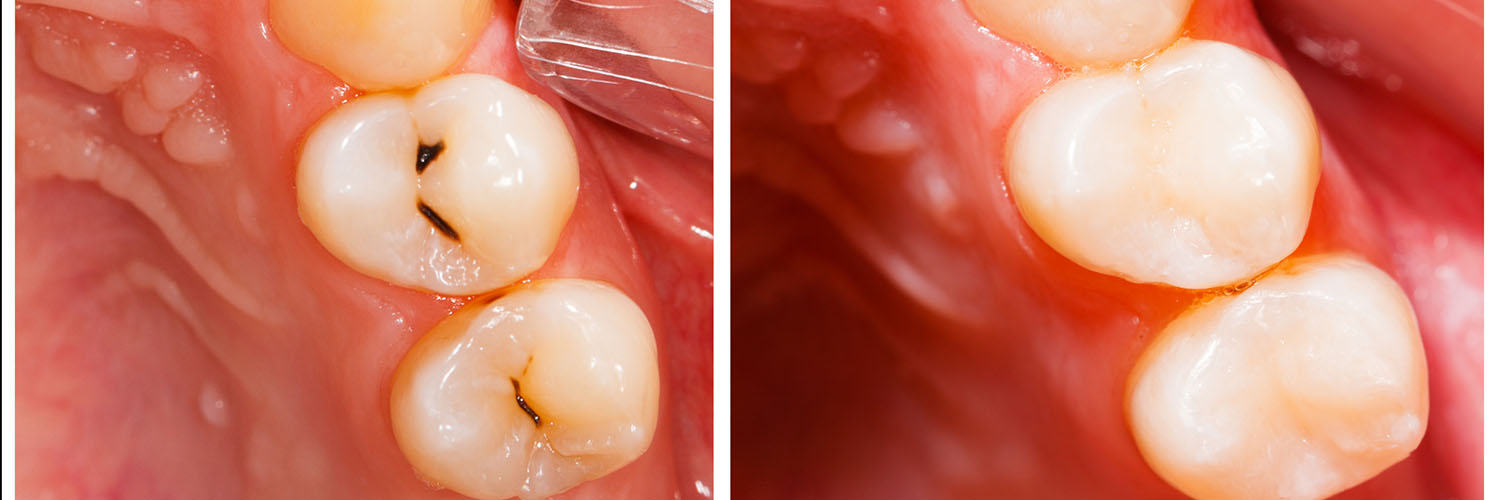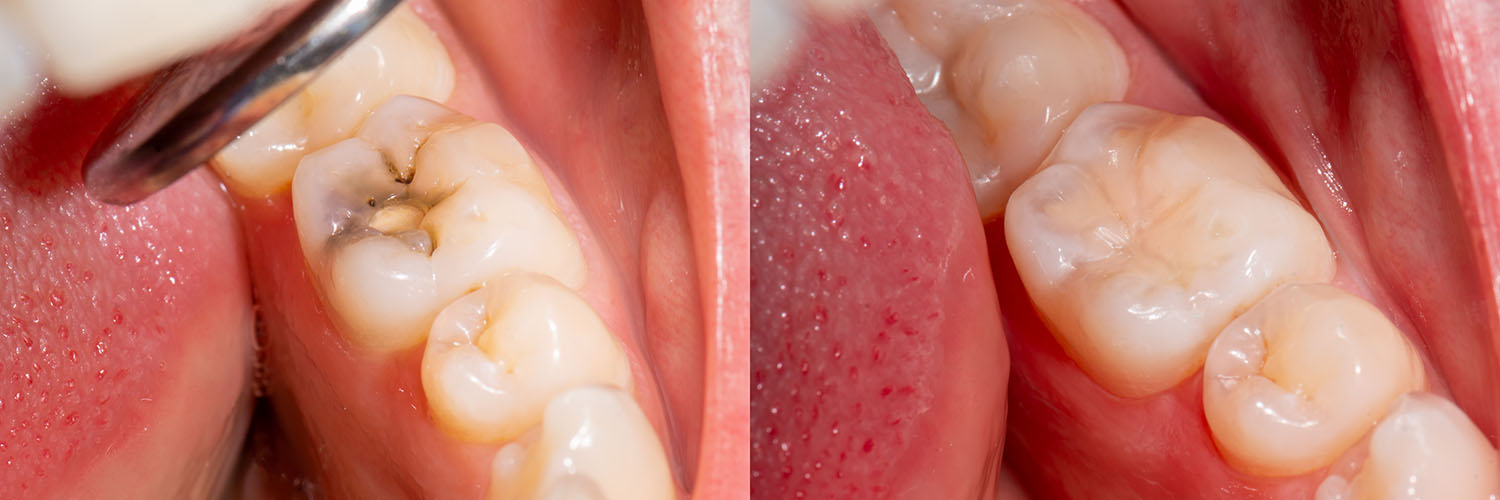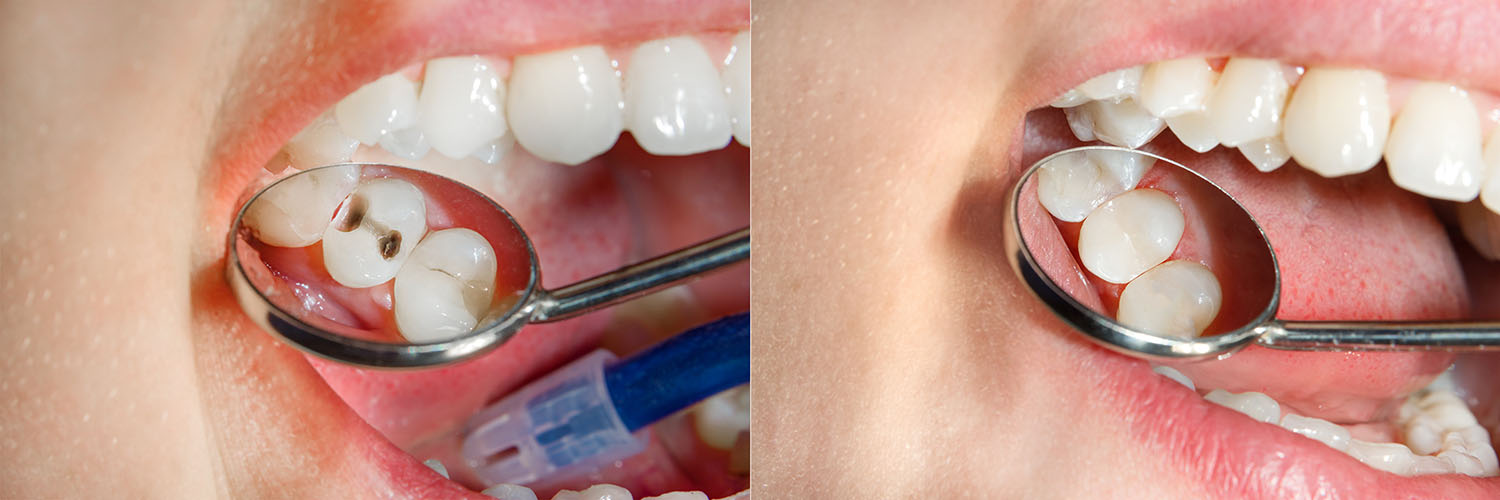Serving Avondale and the West Valley
Serving Avondale and the West Valley

When a tooth has been compromised by decay or minor damage, a well-placed filling restores its shape and function while preventing further deterioration. Fillings rebuild the chewing surface, reestablish contact with neighboring teeth, and seal vulnerable areas to keep bacteria out. The result is a durable repair that helps you maintain natural tooth structure instead of resorting to more extensive treatment.
Tooth decay is common across all ages, so filling procedures remain one of the most frequently performed treatments in general dentistry. Advances in materials and bonding techniques mean that modern fillings are more conservative and longer lasting than their predecessors. Today’s approach emphasizes preserving healthy tooth tissue and choosing a material that balances strength, longevity, and appearance.
Our team prioritizes predictable outcomes and patient comfort. At Summit Family Dentistry, we focus on evidence-based techniques and gentle preparation methods so you leave the office with a restoration that functions well and looks natural. We’ll explain the options available to you and help select the material that best fits the health and appearance goals for your smile.
Humanity has attempted to repair damaged teeth for millennia, and archaeological finds show evidence of early restorative efforts. Over time, materials evolved from rudimentary fillers to metals like gold and, later, amalgam — an affordable, strong alloy that became widespread during the 19th and 20th centuries. Those approaches prioritized durability at a time when aesthetics were a secondary concern.
More recently, shifts in patient expectations and material science have driven the development of tooth-colored restoratives. Composite resins, glass ionomers, ceramic inlays, and other alternatives offer cosmetic benefits while providing adequate strength for many situations. Because these materials bond to tooth structure, they can often preserve more natural enamel and dentin during preparation.
Each generation of materials brought trade-offs between appearance, ease of placement, wear resistance, and longevity. Today’s clinicians choose materials thoughtfully, matching the restorative option to the size and location of the defect, the patient’s bite forces, and cosmetic goals — all while minimizing future risks to the tooth.

Not all fillings are the same. Material choice affects how a restoration looks, how it wears over time, and how much natural tooth must be removed to place it. Understanding the strengths and limitations of each option helps you make an informed decision with your dentist.
Clinicians consider several factors when recommending a material: the size of the cavity, the location of the tooth, cosmetic priorities, and how long the restoration will need to withstand chewing forces. Some materials are best for small, front-facing cavities where appearance matters most; others excel in durability for posterior teeth.
Below are commonly used restorative materials and what you can expect from each, presented in plain language so you can weigh appearance, longevity, and suitability for your specific needs.
Composite resin is a versatile, aesthetic option that matches the shade of your natural teeth. It consists of a plastic matrix reinforced with glass or ceramic fillers, creating a material that is sculptable and polishable for lifelike results. Because it bonds directly to tooth structure, composite often requires removing less healthy tooth tissue.
Composite performs well in small- to medium-sized restorations and is commonly used for front and back teeth alike. Over time it can experience gradual wear or staining, but with proper care and occasional refinishing or replacement, composite restorations provide a reliable, discreet solution.
Amalgam is a long-established material known for durability and resistance to wear. It remains a practical option for large cavities in teeth that endure heavy chewing forces. Amalgam does not mimic natural tooth color, so it’s most often used in areas where aesthetics are less visible.
Glass ionomers bond chemically to the tooth and release fluoride over time, which can help reduce the risk of new decay at the margins. They are especially useful for small restorations near the gumline, for pediatric dentistry, or as a temporary or transitional material in complex treatment plans.
While convenient and protective, glass ionomers are generally less wear-resistant than composite or amalgam and are chosen when their specific benefits outweigh durability concerns.
Ceramic restorations — often fabricated from dental porcelain or advanced glass-ceramics — offer excellent aesthetics and long-term color stability. When a large portion of the biting surface is damaged but a full crown is not necessary, an inlay or onlay can restore form and function with high strength and a natural appearance.
These restorations are crafted outside the mouth (indirectly) and then bonded to the prepared tooth, providing a precision fit and excellent resistance to staining over time.
Gold alloys are still used in certain restorative situations due to their excellent fit, longevity, and biocompatibility. They resist fractures and wear and are forgiving under heavy bite forces, though they are typically chosen for patients who prioritize durability over cosmetic match.

A filling appointment usually begins with a thorough evaluation that may include digital X-rays and an exam to determine the extent of decay. We’ll discuss the recommended material and the steps involved before any treatment begins so you know what to expect. Your comfort and informed consent are always prioritized.
Most routine fillings are placed under local anesthesia so the tooth is numb and you feel little to no discomfort. The decayed portion of the tooth is removed with precise instruments — this can include traditional rotary instruments, air abrasion, or laser techniques depending on the clinical situation and the tools available in the practice.
Once the cavity is cleaned and prepared, the chosen material is placed and shaped to restore proper chewing surfaces and contacts with neighboring teeth. Composites are cured with a light and polished; indirect restorations are fabricated and cemented at a follow-up visit. The dentist will check and adjust your bite to ensure comfort and proper function before you leave.
For patients who experience dental anxiety, clinicians can discuss strategies to improve comfort, including relaxation techniques and options for managing stress during treatment. Every effort is made to make the appointment as calm and efficient as possible.
After a filling, it’s normal to notice temporary sensitivity or a slightly different chewing sensation as your mouth adjusts. Numbness from local anesthesia usually wears off within a couple of hours; until sensation returns, avoid chewing on the treated side to prevent accidental injury. Mild sensitivity to hot or cold tends to resolve over days to weeks.
Proper home care is essential for the longevity of any restoration: maintain routine brushing and flossing, use fluoride toothpaste, and keep up with regular dental checkups so your dentist can monitor the integrity of the filling. Avoid using teeth as tools or chewing on unusually hard objects, as trauma can chip or dislodge restorations.
If you experience persistent or worsening pain, a change in bite that doesn’t improve, roughness on the filling surface, or visible damage to the restoration, contact the office for an evaluation. Early attention can often preserve the underlying tooth and prevent more extensive treatment down the road.
Protect numb tissues: Expect temporary numbness and avoid hot liquids and chewing until feeling returns.
Watch for sensitivity: Mild sensitivity is common; report prolonged or worsening pain so your dentist can assess the tooth.
Keep restorations clean: Daily oral hygiene and routine exams extend the life of fillings and reduce future decay risk.
Know when to follow up: Any sharp pain, a persistent bite issue, or fracturing of the filling warrants prompt attention.
We aim to help patients maintain healthy, functional smiles with restorations that last. If you have further questions about the types of fillings available or what to expect during treatment, please reach out to learn more. Summit Family Dentistry is here to help you understand your options and choose the approach that suits your oral health and lifestyle.


If the pleasure of eating a delicious bowl of ice cream or sipping a soothing cup of tea gets overshadowed by dental pain that makes you wince; it's time to contact our office. As skilled providers of care, we'll determine what's causing your discomfort and perform the treatment required to alleviate your symptoms and get you back on the road to oral health.
Cavities develop because of an infectious process that causes progressive damage to tooth structure. Despite starting as a pinpoint defect on the outermost enamel layer of your tooth, untreated dental decay progressively compromises more and more healthy tooth structure as it works its way to the inner layers of your tooth.
Yes, you can still develop tooth decay on other surfaces of the tooth, around the margins of an old filling, or in fewer instances, recurrent decay underneath it. For this reason, it's essential to maintain excellent oral hygiene, a diet low in sugary beverages and sweets, and be sure to visit our office for routine checkups and care. While tooth decay is second only to the common cold in frequency, it's almost entirely preventable.
We value the time and comfort of our patients. If cavities are located on adjacent teeth, or in the same section of your smile, it may be possible to treat more than one tooth during your visit. However, how much is done each visit depends on several factors. We keep our patients well informed and tailor every treatment plan and visit to address their unique needs.
Addressing concerns on the presence of elemental mercury in silver fillings, the American Dental Association (ADA), The Center for Disease Control and Prevention (CDC), the FDA, and the World Health Organization have all stated that amalgam restorations do not pose a risk to health. However, individuals with allergies or sensitivities to the metals in dental amalgam are advised to pursue other restorative options.
Dental fillings are performed under local anesthesia to help ensure your comfort throughout the entire procedure. The involved tooth remains completely numb for the extent of your visit. Within one or two hours after the procedure is completed, the local anesthetic will gradually wear off, and normal sensations return.
A tooth-colored composite filling is fully hardened and set by the end of your visit. However, we may advise you to wait a couple of hours until the local anesthesia has completely worn off. This advice is to help ensure you don't accidentally bite your lip, cheek, or tongue while still numb.
The lifetime of a dental filling varies depending on the type of material used. While popular dental materials can last a decade or more with proper care, they can degrade over time, wear down, or even break. When this happens, you may experience some tooth sensitivity, a jagged edge, or a loose or dislodged piece of filling material. Whatever the case may be, it's essential to get the filling replaced before the tooth sustains further damage or other consequences arise. Beyond taking good care of your smile to help ensure the longevity of your fillings, our office regularly checks the status of your existing fillings as part of a routine checkup exam.
Dental fillings are an essential investment that serves to preserve and protect the health of your smile. With that said, how much a filling costs depends on the number of surfaces of the tooth involved and the filling material that is used. Amalgam restorations are the most economical. While tooth-colored composite fillings have a slightly higher cost, they offer the added benefits of being metal-free and much more aesthetically pleasing. Ceramic fillings, inlays, and onlays are more expensive than the preceding options but provide outstanding, long-lasting, and natural-looking results.
Dental insurances typically cover the cost of dental fillings. While we work with you to maximize your insurance benefits, there may still be an out-of-pocket expense. At the office of Summit Family Dentistry, we strive to help you begin care without any additional financial stress or delay.
A dental filling is a restorative material used to repair a tooth that has been damaged by decay or minor trauma. It restores the tooth's shape and function while sealing off areas where bacteria could continue to penetrate. Fillings help preserve as much natural tooth structure as possible to avoid more extensive treatments later.
By rebuilding the chewing surface and reestablishing proper contact with neighboring teeth, a filling helps maintain oral function and prevents further breakdown. Modern techniques and materials allow clinicians to place conservative restorations that blend with the surrounding tooth. The overall goal is a durable repair that keeps the tooth healthy and functional for years to come.
Clinicians evaluate several factors before recommending a material, including the size and location of the cavity, cosmetic priorities, and the forces that tooth must endure during chewing. Small front teeth often prioritize appearance, while back teeth that handle heavy bite forces may need a stronger option. The condition of the remaining tooth structure and the patient's oral habits also guide the decision.
Different materials offer trade-offs among strength, wear resistance, and aesthetics, and your dentist will explain those trade-offs in plain terms. Bonding properties and whether the material helps protect adjacent tooth structure are additional considerations. Together with your preferences, the dentist matches the restorative material to the clinical situation to achieve a predictable result.
A typical filling visit begins with a clinical exam and may include digital X-rays to assess the extent of decay and the tooth's internal health. Your dentist will discuss the recommended material and the steps of the procedure before treatment starts so you know what to expect. Informed consent and patient comfort are prioritized throughout the appointment.
Most routine fillings are placed with local anesthesia so the treated area is numb and you experience little to no pain during preparation. The decayed tissue is removed using precise instruments or alternative tools such as air abrasion or lasers when appropriate, and the chosen material is then placed and shaped to restore proper form. The dentist will check your bite and make final adjustments to ensure comfort and function before you leave.
Most patients feel only minimal discomfort because local anesthesia is used to numb the area before treatment begins. You may sense pressure or vibration during the procedure, but sharp pain is uncommon once the anesthesia has taken effect. After the appointment, the numbness typically wears off within a couple of hours.
Some temporary sensitivity to hot, cold, or chewing is normal for days to weeks as the tooth adjusts to the restoration. For patients who experience anxiety or have a low pain threshold, there are relaxation strategies and comfort measures available to help the visit go smoothly. At Summit Family Dentistry we focus on gentle techniques and clear communication to keep patients comfortable throughout the process.
Immediately after a filling, avoid chewing on the treated side until the numbness has fully worn off to prevent biting your cheek, lip, or tongue. Routine care—brushing twice daily with fluoride toothpaste and flossing once daily—supports the longevity of the restoration and overall oral health. Mild sensitivity to temperature or pressure is common and usually subsides within a few days to weeks.
Avoid using your teeth as tools and refrain from chewing very hard objects that could chip a filling. Keep regular dental checkups so your dentist can monitor the restoration and address any wear or marginal breakdown early. If you notice prolonged sensitivity, a persistent change in bite, or roughness on the restoration, contact the office for an evaluation.
The lifespan of a filling varies widely depending on the material, the size and location of the restoration, and the patient's oral habits. Composite fillings in small to moderate cavities can last many years with good care, while larger restorations or those in high-stress areas may wear sooner. Regular hygiene, dietary choices, and habits such as grinding or clenching affect how quickly a filling deteriorates.
Routine dental examinations allow clinicians to identify wear, marginal leakage, or secondary decay early and recommend repair or replacement as needed. Protective measures such as night guards for bruxism and consistent fluoride use can extend the life of restorations. Ultimately, timely maintenance helps preserve the underlying tooth and avoid more invasive procedures.
Common signs that a filling may be failing include new or worsening pain, prolonged sensitivity to hot or cold, a noticeable change in bite, and a rough or loose feeling at the restoration site. You might also observe discoloration or dark lines at the margin of the filling, which can indicate leakage or secondary decay. In some cases a filling can fracture, which often causes sharp discomfort or a sudden change in function.
If you experience any of these symptoms, prompt evaluation is important because early intervention can often preserve the tooth. Your dentist will assess the restoration and surrounding tooth structure to determine whether repair, replacement, or a different restorative option is indicated. Addressing problems sooner helps avoid more extensive treatment down the road.
Composite resins are strong and versatile for small- to medium-sized restorations and have the clear advantage of matching natural tooth color. Because composites bond directly to tooth structure, they often allow for more conservative preparation and can reinforce the remaining enamel and dentin. In high-stress areas or very large cavities, other materials such as ceramics or metal alloys may offer superior long-term wear resistance.
The choice of material depends on the clinical demands of the tooth and the patient’s priorities for strength and aesthetics. Routine maintenance and avoiding excessive forces on restorations will help composites perform well over time. When appropriate, clinicians may recommend indirect options like inlays or onlays for enhanced durability while preserving an aesthetic appearance.
Inlays, onlays, and crowns are indirect restorations used when a cavity or fracture is too large for a direct filling to provide reliable long-term support. These restorations are fabricated outside the mouth for a precise fit and are bonded or cemented to the prepared tooth. An inlay or onlay preserves more healthy tooth than a crown but still offers greater strength than a large filling when significant structure is missing.
Signs that an indirect restoration may be needed include extensive decay, a cracked or weakened tooth, or a tooth that has undergone root canal therapy. Your dentist will evaluate the remaining tooth and discuss options that balance preservation of structure, function, and appearance. Choosing the appropriate restoration helps protect the tooth from future breakdown and restores comfortable chewing function.
Fillings are suitable for patients of all ages, but material choices and techniques are often tailored to the patient's stage of life and oral health needs. For children, clinicians may favor materials that release fluoride or are easier to place in small mouths, and they consider behavioral management when planning treatment. In older adults, factors such as root caries, reduced salivary flow, and existing restorations influence material selection and preventive strategies.
Care is individualized to protect developing teeth in children and to address wear or medical considerations in older patients. Regular monitoring and preventive care help optimize outcomes across the lifespan. If you have specific concerns about a family member's needs, Summit Family Dentistry can recommend the most appropriate restorative approach based on age and oral health status.

Ready to schedule your next appointment or have questions about our services? Our friendly team is here to help with everything from booking visits to answering questions about your treatment options. We’re committed to making the process simple and stress-free.
Whether you prefer to give us a call or fill out our convenient online contact form, reaching us is quick and easy. Don’t wait to take the first step toward a healthier, more confident smile—contact Summit Family Dentistry today!